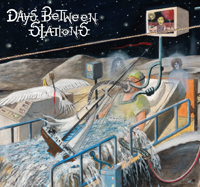
In Extremis (2013)
The American progressive rock scene is getting a new boost with the second album by Days Between Stations. The group is essentially a duo formed by guitarist Sepand Samzadeh and keyboardist Oscar Fuentes. In Extremis is an impressive recording that features numerous guests, including Rick Wakeman (Yes) on keyboards, Peter Banks (Yes/Flash) on guitar, Tony Levin (King Crimson/Peter Gabriel) on bass, Colin Moulding (XTC) on vocals, and Billy Sherwood (Yes) on drums and vocals.
What makes this band truly exciting is its combination of state of the art progressive symphonic rock with elements of fusion, post rock, ambient, classical music and even a little world music.
“There’s the saying that your life flashes before your eyes in near death – and, presumably, actual death – experiences, so the album begins at the climax with ‘No Cause For Alarm’ and, as told on ‘Visionary’, ‘flashes back to the beginning’ and then in not strictly chronological order tells the story of our protagonist’s life,” says Keyboardist Oscar Fuentes about the album. “Not cheerful stuff, I know, but there’s some humor in there and if you read the lyrics I think ultimately it’s a positive message. I’ve had some personal losses in the last few years, so I tend to grapple with that in my lyrics, while Sepand is going to be a father soon…we tried to integrate those two themes, birth and death, into the lyrics.”
The album opens with a dramatic cinematic piece titled ‘No Cause For Alarm’ led by Fuentes’ keyboards, joined by the Angel City Orchestra. This is followed by ‘In Utero’, where the music heads into a Pink Floydian spacey direction with ambient synths, the elegant Angel City brass section and Samzadeh’s mesmerizing lead guitar.
Intensity returns with the lengthy ‘Visionary’ where the band presents fabulous synth work and introduces electronic drums mixed with regular drums and vocals, along with a truly exquisite final guitar section featuring lap steel and dobro. Billy Sherwood dazzles with his drum work in this piece.
‘Blackfoot’ treats the listener to splendid electric guitar work by Samzadeh and an exhilarating stick solo by Tony Levin.
The oddity in the album is a pop song titled ‘The Man Who Died Two Times.’ All I can say is that I always skip it when I listen to this album.
‘Waltz in e minor’ is a delightful neoclassical piece by the Angel City String Quartet dedicated to the late Peter Banks, who died recently.
‘Eggshell Man’ has the finest vocal work on the album. Billy Sherwood demonstrates that can he sing in progressive rock mode (versus AOR) when he sets his mind to it. Sherwood’s vocals blend really well with Fuentes’ gentle mellotron and keyboard work. The evocative nature of the first part of this piece takes you to that magical land of fantasy created by Anthony Phillips. This cut also has the finest musical progression in the album, starting from lovely calm and building towards a vibrant, epic section with Iranian strings, electric piano and Rick Wakeman’s unmistakable minimoog.
The albums ends with a memorable 21-minute suite divided into several parts, where you’ll find an exceptional array of sounds, featuring the core duo along with many of the guests. This an epic piece in classic progressive rock tradition with a brilliant mix of electric, acoustic and orchestral instruments and a wonderful grand finale.
“I really enjoyed working with Days Between Stations, the music is very deep and has a mystique about it that was intriguing from the first time I heard the songs,” says Billy Sherwood comments. “I can’t wait for people to hear this record. Rick Wakeman and Peter Banks of YES, Colin Moulding of XTC and Tony Levin of Peter Gabriel and King Crimson (playing all the bass), all appear as guests on this record which makes it even more unique. I played drums and sang lead vocals on the record and it was a pleasure to do so.”
Sepand Samzadeh describes the differences between the band’s debut album and In Extremis, “There are four clear distinctions between the two albums. The first, is that we are five years older. Which means we have grown as players and have higher expectations of ourselves. The second, which is most noticeable is that we have vocals (with lyrics) on this album. The debut album provides landscapes and layers of sound that allow the imagination to run free.
One negative aspect of having vocals is that the mind mainly focuses on the rhythm and lyrical content and often times constrains the music. We wanted a healthy marriage between the two. Even so, there are several instrumental tracks on this album, one in particular is ‘Blackfoot’.” Oscar continues, “It wasn’t really a conscious decision to add vocals to this one – I mean vocals with lyrics. It’s just how the writing went. Sometimes a song tells you what it needs. So that’s different. Also, the album is more thoroughly composed or let’s say it’s more structurally thought out. Although Sepand and I entirely wrote the music, the lyrics were written collaboratively with Billy Sherwood, who was invaluable in bringing more focus to the whole theme, and who in some cases took the idea in a different direction.”
Sepand adds: “I feel the third difference on the new album is the extensive use of classical and exotic instruments; a full orchestra was employed on the first track, ‘No Cause For Alarm’, an instrumental overture that weaves together many of the main themes from the album. While the track ‘Waltz In E Minor’ is performed by a string quartet, the full orchestra returns (along with an unexpected Barbershop quartet) on the closer, ‘In Extremis’, a 21-plus minute multi-part epic that also features founding YES guitarist Peter Banks. Additionally, a Persian lute called a Tar is featured on the track ‘Eggshell Man’, a song that also features a blistering Moog solo from Yes maestro Rick Wakeman. In fact, on ‘Eggshell Man’ Rick Wakeman, Billy Sherwood and Peter Banks play together. This brings me to my final point; when all these legends came together to contribute on this album, we developed a certain obsession to be at our best. Sadly Peter Banks passed away during the making of ‘In Extremis’, making these recordings even more meaningful and special to us.”
The ‘In Extremis’ album cover artwork was created by renowned artist Paul Whitehead, best known for his work with Genesis and Van Der Graaf Generator. “To us, the artwork for an album is just as important as the music,” says Sepand. “We met with Paul at a coffee shop and I vaguely discussed the concept of the album – as the songs were not fully conceptualized at the time. He came up with some great images – on the spot – about this guy lying on a hospital bed while he was – as our lyrics say – ‘retracing all of the memories’. These memories are whirling around him, while he is in extremis. The great collaboration that we shared with Paul allowed the music and the artwork to become symbiotic…creating a true, tangible concept.”
Days Between Stations was founded in 2003 in the los Angeles area by guitarist Sepand Samzadeh and keyboardist Oscar Fuentes Bills. The adopted the name of a cult novel by Steve Erickson. They describe their music as Art Rock and Post Prog, music that reflects their varied influences, as well as shared indifference for stylistic boundaries,
“We always try to create something new and not just re-hash a particular sound from the past. Sometimes it’s the unlikely pairing that gives you something fresh,” says Oscar Fuentes.
In Extremis is an extraordinary forward thinking progressive rock album by the talented and passionate Sepand Samzadeh and Oscar Fuentes.
Buy In Extremis
